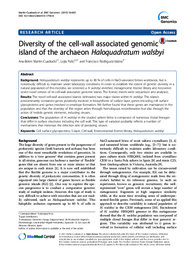Por favor, use este identificador para citar o enlazar este ítem:
https://hdl.handle.net/11000/4811Registro completo de metadatos
| Campo DC | Valor | Lengua/Idioma |
|---|---|---|
| dc.contributor.author | Martín Cuadrado, Ana Belén | - |
| dc.contributor.author | Pašić, Lejla | - |
| dc.contributor.author | Rodríguez Valera, Francisco | - |
| dc.contributor.other | Departamentos de la UMH::Producción Vegetal y Microbiología | es |
| dc.date.accessioned | 2018-09-04T09:46:39Z | - |
| dc.date.available | 2018-09-04T09:46:39Z | - |
| dc.date.created | 2015-08-13 | - |
| dc.date.issued | 2018-09-04 | - |
| dc.identifier.issn | 1471-2164 | - |
| dc.identifier.uri | http://hdl.handle.net/11000/4811 | - |
| dc.description.abstract | Background: Haloquadratum walsbyi represents up to 80 % of cells in NaCl-saturated brines worldwide, but is notoriously difficult to maintain under laboratory conditions. In order to establish the extent of genetic diversity in a natural population of this microbe, we screened a H. walsbyi enriched metagenomic fosmid library and recovered seven novel version of its cell-wall associated genomic island. The fosmid inserts were sequenced and analysed. Results: The novel cell-wall associated islands delineated two major clades within H. walsbyi. The islands predominantly contained genes putatively involved in biosynthesis of surface layer, genes encoding cell surface glycoproteins and genes involved in envelope formation. We further found that these genes are maintained in the population and that the diversity of this region arises through homologous recombination but also through the action of mobile genetic elements, including viruses. Conclusions: The population of H. walsbyi in the studied saltern brine is composed of numerous clonal lineages that differ in surface structures including the cell wall. This type of variation probably reflects a number of mechanisms that minimize the infection rate of predating viruses | es |
| dc.description.sponsorship | All authors were supported by project MICROGEN (Programa CONSOLIDER-INGENIO 2010 CSD2009-00006) from the Spanish Ministerio de Ciencia e Innovación. | - |
| dc.description.sponsorship | FR-V and AMBC received support from MEDIMAX BFPU2013- 48007-P from the Spanish Ministerio de Economía y Competitividad | - |
| dc.description.sponsorship | MaCuMBA Project 311975 of the European Commission FP7 | - |
| dc.description.sponsorship | ACOMP/2014/024, AORG 2014/032 and PROMETEO II/2014/012. LP received support from Ministry for School and Sports of the Republic of Slovenia under Slovenian Research Agency program P1-0198. | - |
| dc.format | application/pdf | es |
| dc.format.extent | 12 | es |
| dc.language.iso | eng | es |
| dc.rights | info:eu-repo/semantics/openAccess | es |
| dc.subject | Cell surface glycoproteins | es |
| dc.subject | S-layer | es |
| dc.subject | Cell-wall | es |
| dc.subject | Environmental fosmid library | es |
| dc.subject | Haloquadratum walsbyi | es |
| dc.subject.other | 579 - Microbiología | es |
| dc.title | Diversity of the cell-wall associated genomic island of the archaeon Haloquadratum walsbyi | es |
| dc.type | info:eu-repo/semantics/article | es |
| dc.identifier.doi | 10.1186/s12864-015-1794-8 | - |
| dc.relation.publisherversion | https://doi.org/10.1186/s12864-015-1794-8 | - |

Ver/Abrir:
Diversity of the cell-wall associated genomic island of the archaeon Haloquadratum walsbyi..pdf
1,69 MB
Adobe PDF
Compartir:
 La licencia se describe como: Atribución-NonComercial-NoDerivada 4.0 Internacional.
La licencia se describe como: Atribución-NonComercial-NoDerivada 4.0 Internacional.
.png)